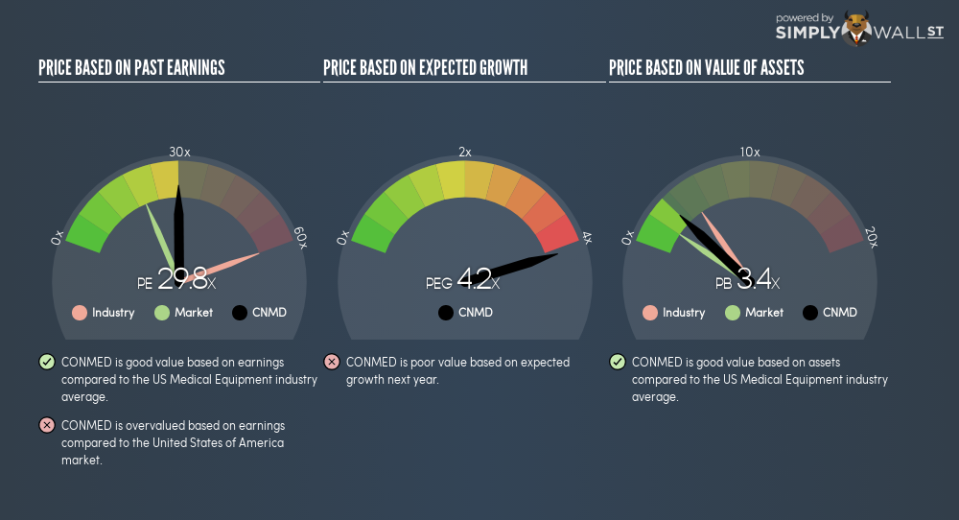Is CONMED Corporation (NASDAQ:CNMD) Attractive At Its Current PE Ratio?

This analysis is intended to introduce important early concepts to people who are starting to invest and want to start learning about core concepts of fundamental analysis on practical examples from today’s market.
CONMED Corporation (NASDAQ:CNMD) trades with a trailing P/E of 29.8x, which is lower than the industry average of 60.1x. Although some investors may jump to the conclusion that this is a great buying opportunity, understanding the assumptions behind the P/E ratio might change your mind. Today, I will break down what the P/E ratio is, how to interpret it and what to watch out for.
View our latest analysis for CONMED
Breaking down the P/E ratio
P/E is a popular ratio used for relative valuation. It compares a stock’s price per share to the stock’s earnings per share. A more intuitive way of understanding the P/E ratio is to think of it as how much investors are paying for each dollar of the company’s earnings.
P/E Calculation for CNMD
Price-Earnings Ratio = Price per share ÷ Earnings per share
CNMD Price-Earnings Ratio = $77.91 ÷ $2.615 = 29.8x
The P/E ratio isn’t a metric you view in isolation and only becomes useful when you compare it against other similar companies. We preferably want to compare the stock’s P/E ratio to the average of companies that have similar features to CNMD, such as capital structure and profitability. A quick method of creating a peer group is to use companies in the same industry, which is what I will do. Since CNMD’s P/E of 29.8 is lower than its industry peers (60.1), it means that investors are paying less for each dollar of CNMD’s earnings. This multiple is a median of profitable companies of 25 Medical Equipment companies in US including QT Vascular, Lantheus Holdings and Escalon Medical. One could put it like this: the market is pricing CNMD as if it is a weaker company than the average company in its industry.
A few caveats
However, it is important to note that this conclusion is based on two key assumptions. Firstly, our peer group contains companies that are similar to CNMD. If this isn’t the case, the difference in P/E could be due to other factors. For example, if you compared higher growth firms with CNMD, then its P/E would naturally be lower since investors would reward its peers’ higher growth with a higher price. The second assumption that must hold true is that the stocks we are comparing CNMD to are fairly valued by the market. If this does not hold true, CNMD’s lower P/E ratio may be because firms in our peer group are overvalued by the market.
What this means for you:
Since you may have already conducted your due diligence on CNMD, the undervaluation of the stock may mean it is a good time to top up on your current holdings. But at the end of the day, keep in mind that relative valuation relies heavily on critical assumptions I’ve outlined above. Remember that basing your investment decision off one metric alone is certainly not sufficient. There are many things I have not taken into account in this article and the PE ratio is very one-dimensional. If you have not done so already, I highly recommend you to complete your research by taking a look at the following:
Future Outlook: What are well-informed industry analysts predicting for CNMD’s future growth? Take a look at our free research report of analyst consensus for CNMD’s outlook.
Past Track Record: Has CNMD been consistently performing well irrespective of the ups and downs in the market? Go into more detail in the past performance analysis and take a look at the free visual representations of CNMD’s historicals for more clarity.
Other High-Performing Stocks: Are there other stocks that provide better prospects with proven track records? Explore our free list of these great stocks here.
To help readers see past the short term volatility of the financial market, we aim to bring you a long-term focused research analysis purely driven by fundamental data. Note that our analysis does not factor in the latest price-sensitive company announcements.
The author is an independent contributor and at the time of publication had no position in the stocks mentioned. For errors that warrant correction please contact the editor at editorial-team@simplywallst.com.

